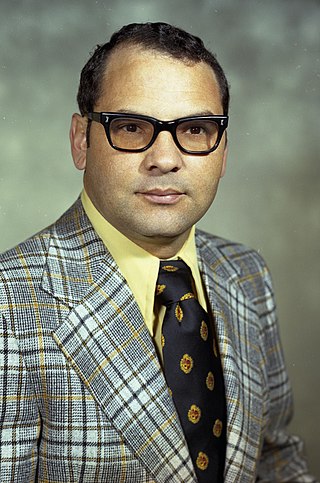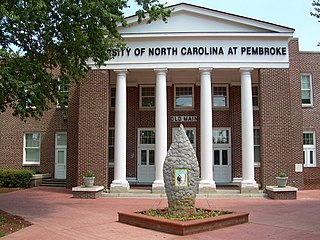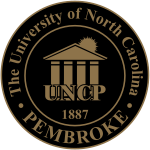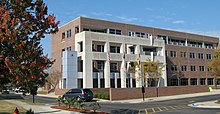
The University of North Carolina is the public university system for the state of North Carolina. Overseeing the state's 16 public universities and the NC School of Science and Mathematics, it is commonly referred to as the UNC System to differentiate it from its flagship, UNC-Chapel Hill.

The University of North Carolina at Greensboro is a public research university in Greensboro, North Carolina. It is part of the University of North Carolina system. It is accredited by the Southern Association of Colleges and Schools Commission on Colleges to award baccalaureate, master's, specialist, and doctoral degrees.

Robeson County is a county in the southern part of the U.S. state of North Carolina and is its largest county by land area. Its county seat and largest community is Lumberton. The county was formed in 1787 from part of Bladen County and named in honor of Thomas Robeson, a colonel who had led Patriot forces in the area during the Revolutionary War. As of the 2020 census, the county's population was 116,530. It is a majority-minority county; its residents are approximately 38 percent Native American, 22 percent white, 22 percent black, and 10 percent Hispanic. It is included in the Fayetteville-Lumberton-Pinehurst, NC Combined Statistical Area. The state-recognized Lumbee Tribe of North Carolina is headquartered in Pembroke.

Pembroke is a town in Robeson County, North Carolina, United States. It is about 90 miles inland and northwest from the Atlantic Coast. The population was 2,823 at the 2020 census. The town is the seat of the state-recognized Lumbee tribe of North Carolina, as well as the home of the University of North Carolina at Pembroke.
Prospect is a census-designated place (CDP) in Robeson County, North Carolina, United States. The population was 690 at the 2000 census. Located due northeast of Pembroke, Prospect is a traditionally Methodist community, with its church members largely becoming representatives for the entirety of the American Indian-Methodist community. Prospect is noted for one of its native sons, Adolph Dial, whose contributions to American Indian Studies have led to an heightened awareness of the local Lumbee Tribe and Native Americans throughout the Southeastern United States.

The University of North Carolina at Charlotte is a public research university in Charlotte, North Carolina. UNC Charlotte offers 24 doctoral, 66 master's, and 79 bachelor's degree programs through nine colleges. It is classified among "R2: Doctoral Universities – High research activity".
David Franklin Weinstein was a politician in North Carolina. He served as Democratic member of the General Assembly who represented the state's thirteenth Senate district, including Hoke and Robeson counties.
The Lumbee are a Native American people primarily centered in Robeson, Hoke, Cumberland, and Scotland counties in North Carolina.

The Battle of Hayes Pond, also known as the Battle of Maxton Field or the Maxton Riot, was an armed confrontation between members of a Ku Klux Klan (KKK) organization and Lumbee people at a Klan rally near Maxton, North Carolina, on the night of January 18, 1958. The clash resulted in the disruption of the rally and a significant amount of media coverage praising the Lumbees and condemning the Klansmen.

The UNCP School of Business is located within the University of North Carolina at Pembroke. All undergraduate and graduate degree programs are fully accredited by the Association to Advance Collegiate Schools of Business (AACSB).
The UNC Pembroke Braves football team represents the University of North Carolina at Pembroke in college football, competing in the Mountain East Conference. Pembroke plays its home games at the 4,000 seat Grace P. Johnson Stadium at Lumbee Guaranty Bank Field, which is located on-campus in Pembroke, North Carolina. Although only fielding a modern team since the 2007 season, Pembroke previously fielded teams between the 1946 and 1950 seasons as Pembroke State.

The UNC Pembroke Braves are the athletic teams that represent the University of North Carolina at Pembroke, located in Pembroke, North Carolina, in NCAA Division II intercollegiate sports.

The Lumbee Tribe of North Carolina is a state-recognized tribe in North Carolina. The tribe represents Lumbee people. They do not hold federal recognition as a Native American tribe.
Allen Coats Meadors is an American professor and university administrator.
The Lumbee Regional Development Association (LRDA) is a nonprofit corporation, chartered by the State of North Carolina in 1968, organized to analyze and develop solutions for the health, educational, economic, and general welfare problems of rural and urban Indians in and around Robeson County. Its effective domain includes, but is not limited to, the Counties of Robeson, Hoke, Scotland, and Bladen, i.e., North Carolina’s Planning Region N. Federally funded programs are currently administered by the Lumbee citizens of these neighboring counties, from the LRDA offices in Pembroke, North Carolina. LRDA currently serves over 20,600 people each year. In July 2009, it had 62 full-time employees.
Adolph Lorenz Dial was an American historian, professor of history at the University of North Carolina at Pembroke, and a specialist in American Indian Studies. Dial was a member of the Lumbee Tribe and a graduate of Pembroke State College, where he obtained a bachelor's degree in social studies. Soon after graduating, Dial enlisted with the United States Army, completing a tour of duty in the European theater of World War II. Post-military, Dial obtained his master's degree and an advanced certificate in social studies from Boston University. Hired by Pembroke State College in 1958, Dial would go on to create the college's American Indian Studies program, the first of its kind at any university in the Southeast. In addition to his role in academia, Dial was a member of the North Carolina House of Representatives for a single term. Over the course of his career, Dial devoted the majority of his academic work towards enriching and publicizing the history of the Lumbee Tribe and its importance within the history of North Carolina, and within the greater narrative of Native American peoples. Dial died on December 24, 1995, 12 days after his 73rd birthday.
Ruth Dial Woods was an American educator and activist. A member of the Lumbee Tribe of North Carolina, she was the first woman to serve as the associate superintendent of the Robeson County Public Schools and to receive an at-large appointment to the University of North Carolina Board of Governors. After teaching in the public school system of Robeson County for 27 years, she joined the faculty at Fayetteville State University. In addition to her work as an educator, Woods was involved in the Civil Rights Movement, the Women's liberation movement, and the American Indian Movement. She has served as a community development consultant for the United States Department of Labor and as a consultant for the Lumbee Tribal Council for administration of tribal programs. The recipient of numerous awards and honors for her work in human rights and education, in 2011, she was inducted into the North Carolina Women's Hall of Fame.

Henry Ward Oxendine was an American lawyer and politician who served as a member of the North Carolina House of Representatives for the 21st District from 1973 to 1976. A member of the Lumbee tribe, he was the first Native American to serve in the North Carolina General Assembly.
Pates is a community in Robeson County, North Carolina, United States.

The Old Main is a historic building on the campus of the University of North Carolina at Pembroke in Pembroke, North Carolina. Completed in 1923, it was the first brick building on the university's campus, then known as the Cherokee Indian Normal School of Robeson County. The building originally hosted classrooms, auditorium space, and administrative offices. After administrative officials moved to a new building in 1949, the structure acquired the "Old Main" name. Since it was used for other community events, it gained additional importance to the primarily Native American student body at the school. Old Main was slated for destruction in 1972, but this decision was overturned after protests by community members. A fire, likely the result of arson, gutted the building in 1973. It was listed on the National Register of Historic Places in 1976 and fully restored and reopened in 1979. It presently hosts several university departments and student media outlets.






















